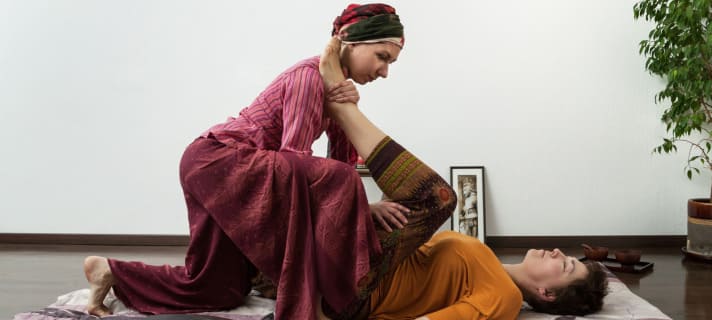Thai massage, also known as “Nuad Boran” or “ancient massage,” is a therapeutic art that dates back thousands of years. Rooted in the rich tradition of Thai culture and influenced by elements of traditional medicine, yoga, and Ayurveda, Thai massage has gained popularity worldwide for its unique healing benefits. If you’re considering delving into the world of Thai massage, this article will provide you with insights into what to expect during your training journey.
The Roots of Thai Massage
Before you embark on your Thai massage training, it’s essential to understand the history and philosophy behind this ancient practice. Thai massage has its origins in the Buddhist temples of Thailand, where it was developed as a form of healing therapy to promote physical and spiritual well-being. This practice is deeply rooted in the belief that the body contains energy pathways, known as “sen lines,” and the manipulation of these lines can lead to improved health.
Learning the Techniques
A fundamental aspect of Thai massage training is mastering the techniques that have been passed down through generations. These techniques involve a combination of acupressure, stretching, and yoga-like postures. Thai massage therapists use their hands, elbows, knees, and feet to apply pressure to specific points on the body while guiding clients through various stretches and movements.
During your training, you’ll learn the intricacies of applying pressure along the sen lines to release tension and promote the flow of energy. These techniques are designed not only to alleviate physical discomfort but also to restore balance and harmony within the body.
Understanding Traditional Thai Medicine
To become a proficient Thai massage practitioner, it’s crucial to have a solid understanding of traditional Thai medicine. This holistic approach to healing encompasses herbal remedies, dietary guidelines, and energy balancing. You’ll learn how to incorporate these elements into your practice, tailoring your treatments to each client’s unique needs.
Benefits of Thai Massage
Thai massage is renowned for its numerous health benefits. As a practitioner in training, you’ll explore these benefits in-depth. They include:
Pain Relief
Thai massage can effectively alleviate chronic pain, muscle tension, and joint stiffness.
Stress Reduction
The gentle, rhythmic movements of Thai massage induce relaxation and reduce stress.
Improved Flexibility
Through assisted stretching, clients can experience increased flexibility and range of motion.
Enhanced Circulation
Thai massage promotes better blood circulation, aiding in overall well-being.
Emotional Healing
Many clients report emotional release and improved mental clarity after a Thai massage session.
Thai Massage Certification
Becoming a certified Thai massage practitioner involves completing a structured training program. These programs vary in duration, ranging from a few weeks to several months. It’s essential to choose a reputable school or training center that adheres to traditional techniques and principles.
Certification typically involves practical and theoretical assessments to ensure you have a comprehensive understanding of Thai massage. Once certified, you’ll be ready to practice professionally, helping clients experience the many benefits of this ancient art.
Thai Massage Schools
There are numerous Thai massage schools around the world, each offering its unique approach and curriculum. When selecting a school for your training, consider factors such as the reputation of the institution, the qualifications of the instructors, and the types of massage techniques covered in the program.
Many schools offer immersive experiences, where you can not only learn the art of Thai massage but also gain cultural insights into Thailand and its traditions. These experiences can be transformative, deepening your connection to the practice.
The Role of Sen Lines
A fundamental aspect of Thai massage training is the understanding and manipulation of sen lines. Sen lines are similar to the concept of meridians in Traditional Chinese Medicine and play a crucial role in Thai massage therapy. You’ll learn how to identify these lines and use them to guide your massage techniques effectively.
Practical Experience
While theory and technique are vital components of Thai massage training, practical experience is equally important. You’ll have the opportunity to practice your skills on real clients under the guidance of experienced instructors. This hands-on experience is invaluable in honing your abilities and building confidence as a practitioner.
Continuing Education
After completing your initial Thai massage training and obtaining certification, your journey doesn’t end. Many practitioners choose to pursue advanced courses or specialize in specific areas, such as prenatal Thai massage or therapeutic applications for specific conditions. Continuing education allows you to refine your skills and offer more specialized services to your clients.
Becoming a Thai Massage Practitioner
Upon completing your training and certification, you’ll be well-equipped to embark on a fulfilling career as a Thai massage practitioner. Whether you choose to work independently, in a spa, or alongside other healthcare professionals, you’ll have the skills to provide therapeutic and holistic care to your clients.
Thai massage is a centuries-old healing art that offers numerous benefits to both practitioners and clients. By embarking on the journey of Thai massage training, you’ll gain a deep understanding of its history, techniques, and philosophy. This ancient practice not only has the potential to transform your life but also the lives of those you touch through your healing hands. Embrace the tradition, and let Thai massage become a profound part of your wellness journey.

